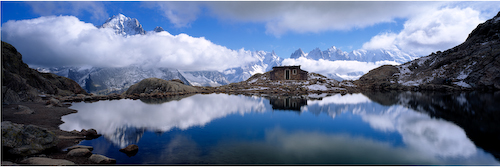Valhalla

Many places simply defy description.
And, that's a good thing… because when I travel, my favorite souvenir by far (more than a trinket, piece of artwork, or antique) is an image that will echo my own splendid experience to the viewer. I treasure an image that will let me share a jaw-dropping spectacular location or vista; it's like finding the perfect gift for a friend. This image brings back such a moment; it has been dubbed "Valhalla" though it was taken in the French Alps and not in the frozen uplands of Vikings.
On a beautiful August morning, I was hiking from Chamonix. On my back was a Gitzo carbon fiber tripod and a big Linhof Technorama 617 camera. I climbed from green golf courses all the way to snow. Notwithstanding, the scenery propelled me more than my physical condition, as I climbed several thousand vertical feet. The experience was already enriching; I felt satisfied with the day and began making my descent. I remember rounding a bend and being stopped in my tracks; before me was the image you see here, totally and utterly unexpected.
At four frames per roll of Velvia 120 film, I went through about a dozen rolls. I wasn't going to leave anything to chance. Working carefully with a Fuji loupe, Minolta pistol grip type spot meter, ground glass, and lots of depth of field, I worked for over an hour. When I'm in that sort of moment, I tend to forget that I might be cold, hungry or tired.
Now, there are doubters who insist that this vista is a CGI compilation, an impossible reality assembled digitally from disparate pieces. Not so. A stone refuge, little pond, and the jagged alpine background converged together under an impossibly blue sky were as perfectly composed as fruit on a silver platter. Free for the taking and just waiting for me and that big panoramic camera.
I'd found the perfect gift to take home.
- Russ Schleipman

